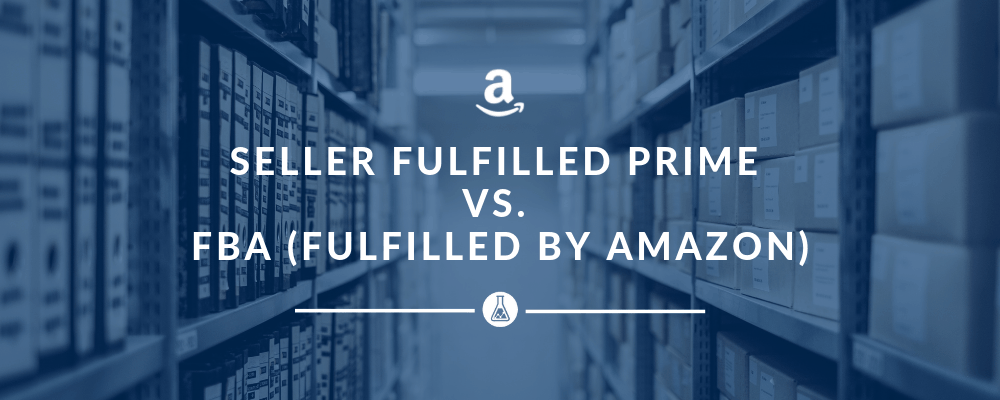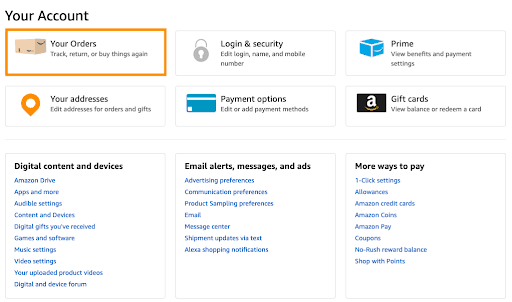After being around for 13 years and growing to 100 million members, Amazon Prime has clearly become a massive success.
The majority of Prime accounts pay an annual fee of $120 to receive their items as fast as possible. When you calculate the revenue on membership fees alone, Amazon Prime is earning the company close to $12 billion in annual revenue.
In addition to paying for the subscriptions, Prime members are spending an average of $1,400 every year. When you compare that to the $600 dollars non-Prime customers are spending, you can see why Amazon encourages their users to sign up!
It’s clear that having the Prime badge is an important part of gaining success when selling on Amazon, but how can you get it?
In order to earn the Prime badge for your listing, you can participate in one of two programs:
- Seller Fulfillment Prime (SFP).
- Fulfillment by Amazon (FBA)
What is Seller Fulfilled Prime? What is Fulfillment by Amazon?
Fulfilled by Amazon is Amazon’s in-house fulfillment center provided to sellers. Basically, sellers send their inventory to Amazon, and when a purchase is made, Amazon ships that product to the buyer. Sellers using Fulfilled by Amazon will qualify for Prime status with the marketplace.
Seller Fulfilled Prime is a fulfillment method that also qualifies for the Prime badge. With Seller Fulfilled Prime, the sellers must complete purchase orders themselves, with their own warehouses and fulfillment methods, while following Amazon’s fulfillment guidelines.
In order to decide which is best for your business, let’s go over each aspect in more detail:
At the end of the article, you’ll be able to find the advantages and disadvantages of Seller Fulfilled Prime (SFP), as well as the Amazon FBA’s pros and cons.
1. Eligibility
Amazon is a brand that is recognized for their innovation. Aside from fully handling customer service and creating their own products, they’ve built an in-house fulfillment center for their sellers.
Seller Fulfilled Prime
With Seller Fulfilled Prime (SFP), you are the one responsible for storing, shipping, and handling your products. Unlike FBA, SFP is a fulfillment method that you have to apply to and be approved for.
Pre-qualifications for SFP include having used Fulfilled by Amazon in the past. This is because before enrolling, you will have to go through a trial period to practice being a part of SFP.
During the trial, you will remove your inventory from Amazon’s warehouses – or sell new inventory, if you don’t want to pay a removal fee – and begin fulfilling orders yourself. These fulfillments must have 0-day handling time, meaning the orders must be shipped the same day they were placed. It isn’t until you pass this trial that your Prime badge will successfully show on your listings.
Currently, Amazon is not taking any applications for SFP, but you can still join their waiting list.
Fulfilled by Amazon
Enrolling in Fulfilled by Amazon (FBA) is easy to do as the option is included in your Seller Plan. Whether you’re an Individual or Professional seller, you qualify.
With Fulfillment by Amazon, once they accept your inventory shipment, Amazon will be responsible for picking, packing, and shipping out your products once purchased. The idea is that Amazon does the heavy lifting while you make a profit.
2. Fulfillment
Seller Fulfilled Prime
Fulfillment is definitely a big catch with Seller Fulfilled Prime. All the costs for shipping and handling have to be covered by you, the seller. If you’re not careful, this can slowly eat away at your profit margin.
Moreover, you have to use Amazon’s Buy Shipping tools to buy shipping labels (individually or in bulk), ship and confirm your orders, and track your shipments. This adds a new layer of logistics to the equation.
Fulfilled by Amazon
As a seller, when you choose FBA, Amazon will handle all order logistics – from storage to customer service.
When shipping your products, many purchases are delivered by Amazon Logistics (AMZL). This carrier is exclusive to Amazon, so they’ve made tracking simple for your (their) customers.
When buyers want to check their order, rather than having a tracking number, they just go straight to their account. In two steps, they can track their purchase.
3. Fees
Seller Fulfilled Prime
When you’re enrolled in Seller Fulfilled Prime, you have the luxury of avoiding all the FBA fees that we mention below. However, that’s not to say that you won’t have any costs of your own.
Once in the program, you have to cover the costs of storing and shipping your products yourself. Your costs will vary and depend on your warehouse options, preferred carrier, and shipping supplies. When it comes to facilitating shipping labels, you will want to look into third-party systems that can integrate with Amazon’s API to maintain efficiency.
Fulfilled by Amazon
With its all-inclusive service, Fulfilled by Amazon is bound to come at a cost. There are two main fees attached to this fulfillment method for sellers to consider:
- Fulfillment Fees: These are fees attached to shipping and handling. It covers order picking and packing services, shipping material such as packing boxes and inner packing, and all shipping costs. Additionally, it covers shipping and handling costs associated with customer returns. However, if the purchase is for “free return” items, there will be a return processing fee.
- Monthly Storage Fees: These fees are for storing your products in Amazon’s warehouses. Amazon calculates your inventory storage fees based on the square cubic footage that your inventory occupies.
4. Storage
Where do you keep everything while you wait for it to sell? Each fulfillment program has an alternative method.
Seller Fulfilled Prime
Seller Fulfilled Prime is all about inventory control and responsibility. You don’t have to share your inventory with Amazon, but you are responsible for all shipping and handling costs and management. This means you have to find and manage a warehouse that will help you maintain high-profit margins as you scale up the business – all while staying within Amazon’s guidelines to maintain your Prime status.
You’re also responsible for picking out the products, packaging, presentation, and protection, and choosing an approved shipping carrier for your inventory. Depending on the product’s size and weight, some carriers will be better than others when it comes to fees.
Fulfilled by Amazon
Fulfillment by Amazon can be seen as a give-and-take when it comes to the control of your inventory. Once it’s in their warehouse, it’s theirs to keep until it’s sold. If for some reason you can’t afford to keep it in Amazon’s space, you can remove it for a fee.
What you lose in control by using FBA, you make up for in time and with the peace of mind knowing that Amazon’s got it covered. They keep everything organized for you and only charge you for what you use so you won’t have to worry about how to scale up warehouse space yourself.
Note: Sellers with a pre-established business don’t need to send all of their inventory to Amazon – they can just send a portion.
5. Returns
The customer is always right! That’s the first rule they teach you in retail, and that’s basically the only rule Amazon lives by. Each program has a different return method.
Seller Fulfilled Prime
When you’re using SFP, you have to take care of the returns while abiding by the same policies as Amazon FBA sellers. In other words, items purchased on Amazon are automatically authorized for a return and, as the seller, you automatically cover the costs.
Though the same rules apply, this isn’t necessarily a bad thing. While you will need to process and handle returns internally, doing so will allow you to keep track of all returned items and which customer they’re tied to – potentially avoiding customer fraud.
Fulfilled by Amazon
As previously mentioned, the fulfillment fees of FBA cover most of the shipping and handling costs involved with returns. Amazon’s first-class customer service will be especially useful for small businesses.
Advantages and Disadvantages of Seller Fulfilled Prime (SFP)
Pros
Cons
- Once you’re a part of SFP, you qualify for Amazon Prime, making you a more attractive option to Amazon’s 100 million Prime members.
- You can compete more effectively for the Amazon Buy Box.
- You have reign over your inventory and customized packaging.
- You can tailor your shipping and handling to how it suits your business the best.
- You have to apply to be considered.
- If you’re off the waiting list, you still have to go through the trial run before you can enroll.
- You have to put more work into finding a warehouse, carrier, and staff to manage your logistics.
- You are responsible for continuous shipping quality control, tracking, returns, and customer service.
- You are under constant pressure to maintain excellent fulfillment.
Advantages and Disadvantages of Fulfilled by Amazon (FBA)
Pros
Cons
- Once you’re a part of FBA, you qualify for Amazon Prime, making you a more attractive option to Amazon’s 100 million Prime members.
- It’s instantly available to you when you sign up.
- Amazon takes care of everything related to shipping and logistics, giving you more time to grow your business.
- They also take over customer service, which can be a big challenge when you’re first starting out.
- You can sell qualified listings with the Prime badge.
- Fees on top of fees! Although, you have to expect that Amazon will want something in return for providing these services.
- You have little to no control over your inventory or packaging.
- If you manage a warehouse of your own to supply customers from your own website, it might not be worth having Amazon manage this for you.
Which is better for your business - FBA or SFP?
Ultimately, you have to evaluate which of these fulfillment methods your business is best fit for.
If you’re a new business and you want to scale up quickly while maintaining a small team, FBA might be your best bet. The scalable, hands-off nature of this fulfillment method makes it perfect for new businesses looking for something that can grow with them.
However, if your business is more established and sells through multiple channels such as your own website, physical retail, or other marketplaces like eBay, SFP might be a better fit for you so that you can manage all of your inventory in one place.

Nicholas Rubright
Nicholas Rubright is a digital marketing specialist for Zik Analytics - a tool that helps entrepreneurs start and grow e-commerce businesses.
You can find him on LinkedIn.





